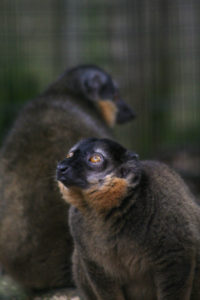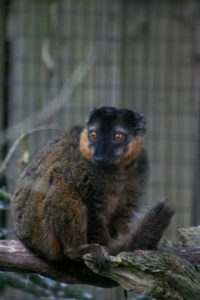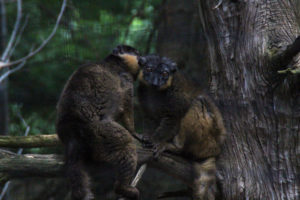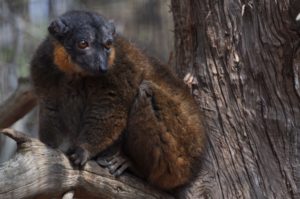COLLARED BROWN LEMUREulemur fulvus
Conservation Status: Endangered
They are most heavily impacted by habitat destruction. They have also been hunted for food and trapped for the pet trade.

Learn More
Color:
The have primarily quadrupedal movement, so they have adopted a horizontal posture as a result. Males are brownish-grey, with their backs being darker than their bellies. The muzzle, forehead, and crown are grey while the males have long fur on their cheeks and have beards that are reddish-brown. They also have a dark stripe running down their backs. The females are more brown and red than grey on the back and are a pale grey on their bellies. Their cheek fur is not nearly as bushy as the males. Both males and females have orange-red eyes.
Size:
39-40 cm head and body, 50-55 cm tail.
Weight:
2.25-2.5 kg
Average Lifespan:
20-25 years
Captive Lifespan:
Up to 36 years
Southeastern Madagascar
They are arboreal (meaning they live up in the trees). The collared lemurs are found primarily in the tropical moist lowland and montane forests.
Mating:
Breeding is seasonal and mating occurs between June and July.
Gestation/Incubation:
120 days
Litter/Clutch Size:
They often have 1 offspring, but occasionally there are twins. Young are born from September to November.
Mature:
1-2 years old
A majority of their diet consists of fruit; however, they will also eat leaves, flowers, bark, and insects.
The collared lemur is cathemeral (active at different times throughout a 24 hour period). They will live in groups of 3-12 lemurs.
1. They can leap large distances in part due to their long tail, which is used for balance.
2. Unlike other lemurs, which have an obvious female dominance, there is no clear dominance hierarchy for the collared brown lemur.
3. They have a lower mortality rate in their young than other lemurs perhaps due to records of males assisting with the care of the young.
4. The collared brown lemur will use scent to mark its territory.









